Software Factory
(Component Description Language)
User’s Guide
CDL
Version 6.5.3 / April 2012
�
1
Copyright © 2012, by OPEN CASCADE S.A.S.
PROPRIETARY RIGHTS NOTICE: All rights reserved. Verbatim copying and distribution of this
entire document are permitted worldwide, without royalty, in any medium, provided the copyright
notice and this permission notice are preserved.
The information in this document is subject to change without notice and should not be construed
as a commitment by OPEN CASCADE S.A.S.
OPEN CASCADE S.A.S. assures no responsibility for any errors that may appear in this
document.
The software described in this document is furnished under a license and may be used or copied
only in accordance with the terms of such a license.
CAS.CADE, Open CASCADE and Open CASCADE Technology are registered trademarks of
OPEN CASCADE S.A.S. Other brand or product names are trademarks or registered trademarks
of their respective holders.
NOTICE FOR USERS:
This User Guide is a general instruction for Open CASCADE Technology study. It may be
incomplete and even contain occasional mistakes, particularly in examples, samples, etc.
OPEN CASCADE S.A.S. bears no responsibility for such mistakes. If you find any mistakes or
imperfections in this document, or if you have suggestions for improving this document, please,
contact us and contribute your share to the development of Open CASCADE Technology:
bugmaster@opencascade.com
http://www.opencascade.com/contact/
1
�
TABLE OF CONTENTS
2
TTAABBLLEE OOFF CCOONNTTEENNTTSS
TABLE OF CONTENTS ............................................................................................................................. 2
1. CDL AND APPLICATION ARCHITECTURE .................................................................................... 4
2. INTRODUCTION TO CDL .................................................................................................................... 6
2.1 PURPOSES OF THE LANGUAGE ............................................................................................................... 6
2. 2 OVERVIEW OF CDL .............................................................................................................................. 7
2. 2. 1 Classes ......................................................................................................................................... 7
2. 2. 2 Categories of Types ..................................................................................................................... 8
2. 2. 3 Persistence ................................................................................................................................... 9
2. 2. 4 Packages .....................................................................................................................................10
2. 2. 5 Inheritance ..................................................................................................................................10
2. 2. 6 Genericity ...................................................................................................................................11
2. 2. 7 Exceptions...................................................................................................................................11
2. 2. 8 Completeness ..............................................................................................................................12
2. 3 LEXICAL CONVENTIONS ......................................................................................................................12
2. 3. 1 Syntax notation ...........................................................................................................................12
2. 3. 2 Lexical elements .........................................................................................................................13
2. 3. 3 Comments ...................................................................................................................................13
2. 3. 4 Identifiers ....................................................................................................................................14
2. 3. 5 Keywords ....................................................................................................................................14
2. 3. 6 Constants ....................................................................................................................................14
3. SOFTWARE COMPONENTS ...............................................................................................................16
3. 1 PREDEFINED RESOURCES .....................................................................................................................16
3. 1. 1 Primitive types ............................................................................................................................16
3. 1. 2 Manipulating types by reference (by handle) .............................................................................16
3. 1. 3 Manipulating types by value .......................................................................................................17
3. 1. 4 Summary of properties ................................................................................................................18
3. 2 CLASSES ..............................................................................................................................................18
3. 2. 1 Class declaration ........................................................................................................................18
3. 2. 2 Categories of classes ..................................................................................................................20
3. 3 PACKAGES ...........................................................................................................................................21
3. 3. 1 Package declaration ...................................................................................................................21
3. 3. 2 Name space .................................................................................................................................24
3. 3. 3 Declaration of classes ................................................................................................................25
3. 4 OTHER DATA TYPES ............................................................................................................................26
3. 4. 1 Enumerations ..............................................................................................................................26
3. 4. 2 Imports ........................................................................................................................................27
3. 4. 3 Aliases ........................................................................................................................................28
3. 4. 4 Exceptions...................................................................................................................................28
3. 5 SCHEMAS .............................................................................................................................................29
3. 6 EXECUTABLES .....................................................................................................................................29
4. DEFINING THE SOFTWARE COMPONENTS ................................................................................31
4. 1 BEHAVIOR ...........................................................................................................................................31
4. 1. 1 Object Constructors ....................................................................................................................31
4. 1. 2 Instance Methods ........................................................................................................................33
4. 1. 3 Class Methods ............................................................................................................................34
4. 1. 4 Package Methods ........................................................................................................................35
4. 1. 5 Sensitivity to Overloading...........................................................................................................35
4. 2 INTERNAL REPRESENTATION ...............................................................................................................36
2
�
4. 3 EXCEPTIONS ........................................................................................................................................36
4. 4 INHERITANCE .......................................................................................................................................37
4. 4. 1 Overview .....................................................................................................................................37
4. 4. 2 Redefining methods.....................................................................................................................38
4. 4. 3 Non-redefinable methods ............................................................................................................39
4. 4. 4 Deferred Classes and Methods ...................................................................................................39
4. 4. 5 Declaration by Association ........................................................................................................40
4. 4. 6 Redefinition of Fields ..................................................................................................................42
4. 5 GENERICITY .........................................................................................................................................42
4. 5. 1 Overview .....................................................................................................................................42
4. 5. 2 Declaration of a Generic Class ..................................................................................................43
4. 5. 3 Instantiation of a Generic Class .................................................................................................45
4. 5. 4 Nested Generic Classes ..............................................................................................................45
4. 6 VISIBILITY ...........................................................................................................................................47
4. 6. 1 Overview .....................................................................................................................................47
4. 6. 2 Visibility of Fields .......................................................................................................................47
4. 6. 3 Visibility of Methods ...................................................................................................................48
4. 6. 4 Visibility of Classes, Exceptions, & Enumerations .....................................................................49
4. 6. 5 Friend Classes & Methods .........................................................................................................49
APPENDIX A. SYNTAX SUMMARY ......................................................................................................51
APPENDIX B. ..............................................................................................................................................56
5. 1 COMPARISON OF CDL & C++ SYNTAX FOR DATA TYPES MANIPULATED BY HANDLE AND BY VALUE
...................................................................................................................................................................56
3
3
�
1. CDL and Application Architecture
4
11.. CCDDLL aanndd AApppplliiccaattiioonn
AArrcchhiitteeccttuurree
CDL is the component definition language of the Open CASCADE programming
platform. Some components, which CDL allows you to create, are specific to Open
CASCADE application architecture. These and other components, which you can
define using CDL include the following:
• Class (including enumeration, exception)
• Package
• Schema
• Executable
• Client.
A class is the fundamental software component in object-oriented development.
Because of a very large number of resources used in large-scale applications, the
class itself is too small to be used as a basic management unit.
So, while the class is the basic data component defined in CDL, this language also
provides a way to group classes, enumerations, and exceptions together – the
package. A package groups together a number of classes, which have semantic
links. For example, a geometry package would contain Point, Line, and Circle
classes. A package can also contain enumerations, exceptions, and package
methods. In practice, a class name is prefixed with the name of its package e.g.
Geom_Circle.
Using the services described in the packages, you can construct an executable.
You can also group together services provided by packages.
To save data in a file, you need to define persistent classes. Then, you group these
classes in a schema, which provides the necessary read/write tools.
4
�
1. CDL and Application Architecture
5
Figure 1. Building an Open CASCADE application
5
�
2. Introduction to CDL
6
22.. IInnttrroodduuccttiioonn ttoo CCDDLL
2.1 Purposes of the Language
You can use CDL to define data in the Open CASCADE environment. CDL allows
you to define various kinds of data types supporting the application architecture and
development methodology, which you envision. CDL is neither an analysis
formalism (e.g. Booch methodology) nor a data manipulation language (e.g. C++).
You use CDL in the design phase of a development process to define a set of
software components which best model the concepts stated in the application
specification.
Figure 2. The Development Process
From a structural point of view, CDL is an object-oriented language. It is centered on
the notion of the class - a data type, which represents an elementary concept. CDL
offers various means of organizing classes, mostly under the fundamental form of
packages. A package contains a set of classes, which share some semantic
relationship. This greatly simplifies your task of managing individual classes when
confronted with a very large number of them.
6
�
2. Introduction to CDL
7
Once you have defined the classes and packages using CDL, you can implement
their methods - i.e., their functionality - in one of the data manipulation languages
supported by the Open CASCADE environment (currently C++).
Even though you can describe classes directly in C++ and save them as header files
(.hxx), to do so would forfeit all the advantages of using CDL. These are:
• Precise, complete, and easy-to-read description of
the software
components.
• Creation of a link with the database; object persistence forms part of the
predefined environment of the language.
• Multi-language access to the services of an application engine – a
specific architectural form created using the CDL tools, which serves as
the motor of an application.
2. 2 Overview of CDL
CDL is an object-oriented language. In other words, it structures a system around
data types rather than around the actions carried out on them. In this context, an
object is an instance of a data type, and its definition determines how you can use
it. Each data type is implemented by one or more classes, which make up the basic
elements of the system.
2. 2. 1 Classes
A class is an implementation of a data type. It defines its behavior and its
representation.
The behavior of a class is its programming interface - the services offered by its
methods. The representation of a class is its data structure - the fields, which store
its data.
Every object is an instance of its class. For example, the object p of the data type
Point is an instance of the class Point.
The class Point could be defined as in the example below:
Example
class Point from GeomPack
---Purpose: represents a point in 3D space.
is
Create returns Point;
fields
x, y, z : Real;
end Point;
7
�

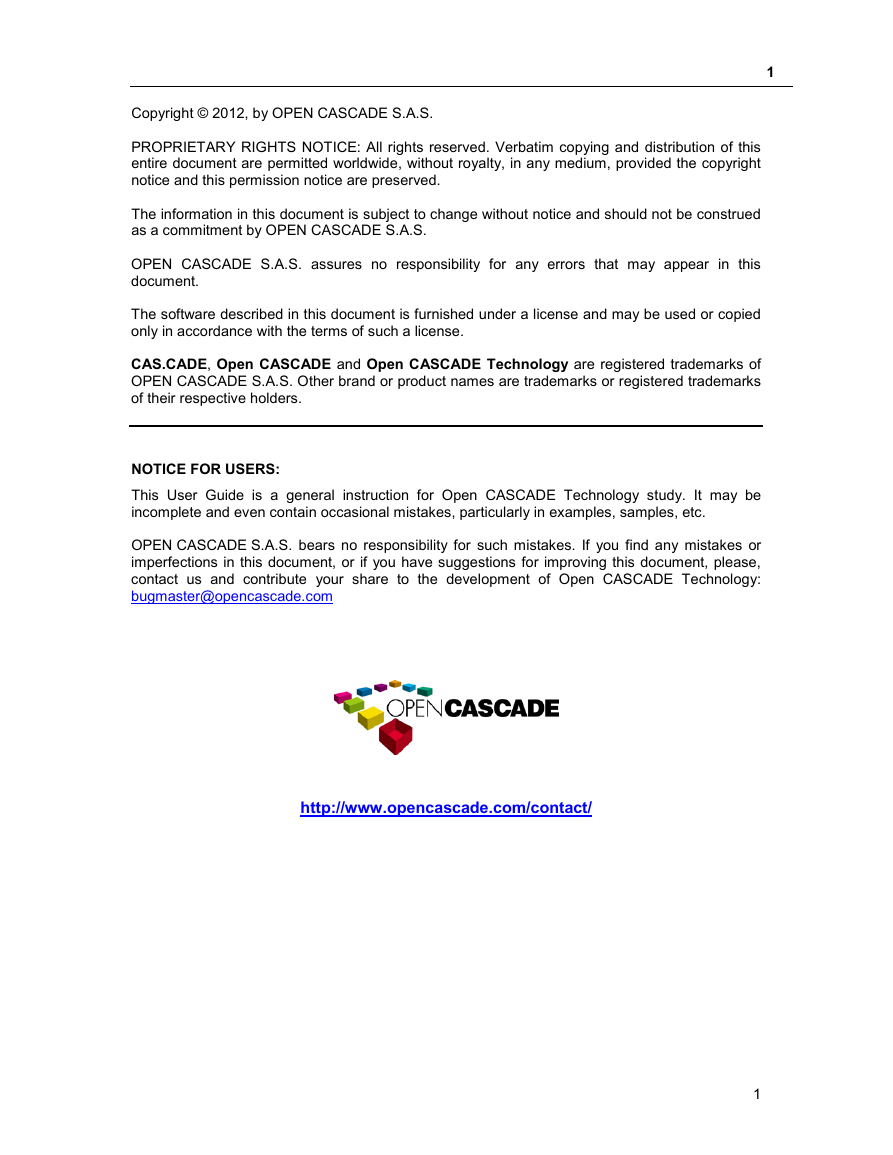
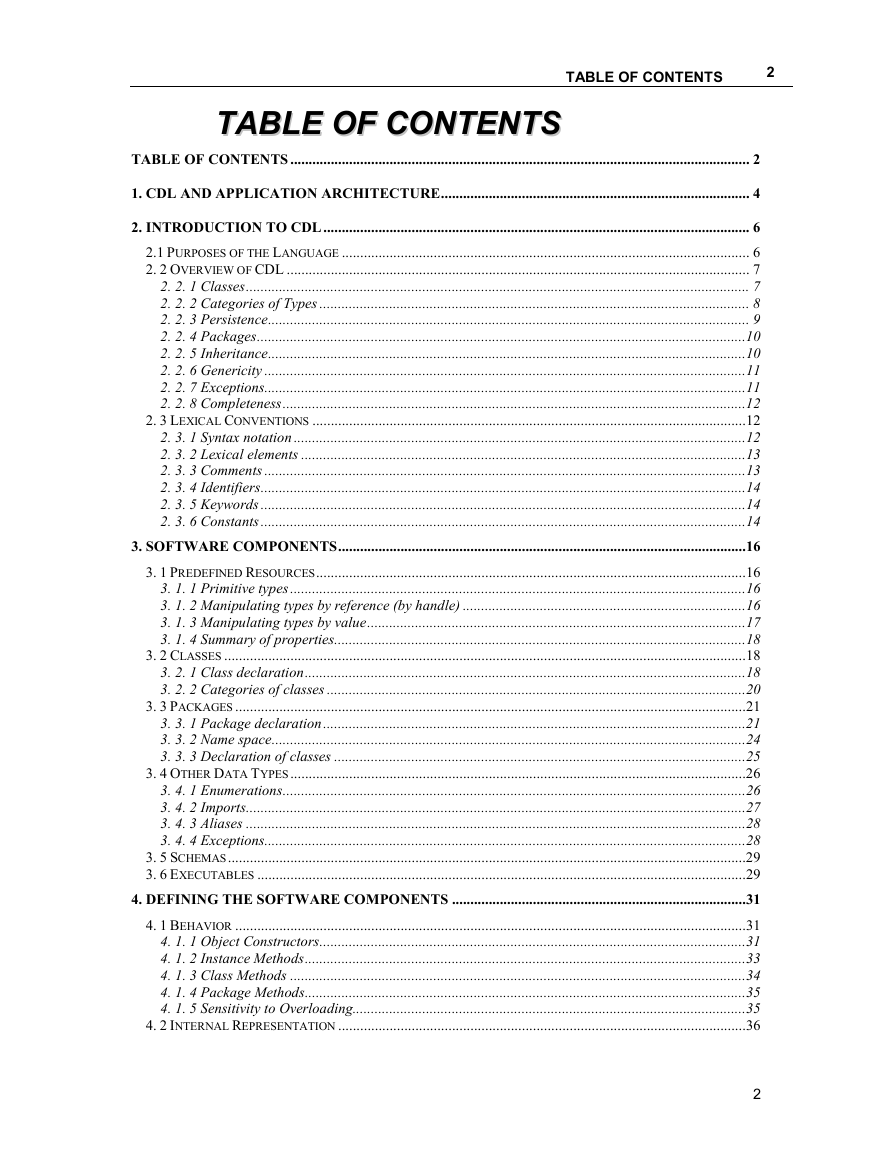
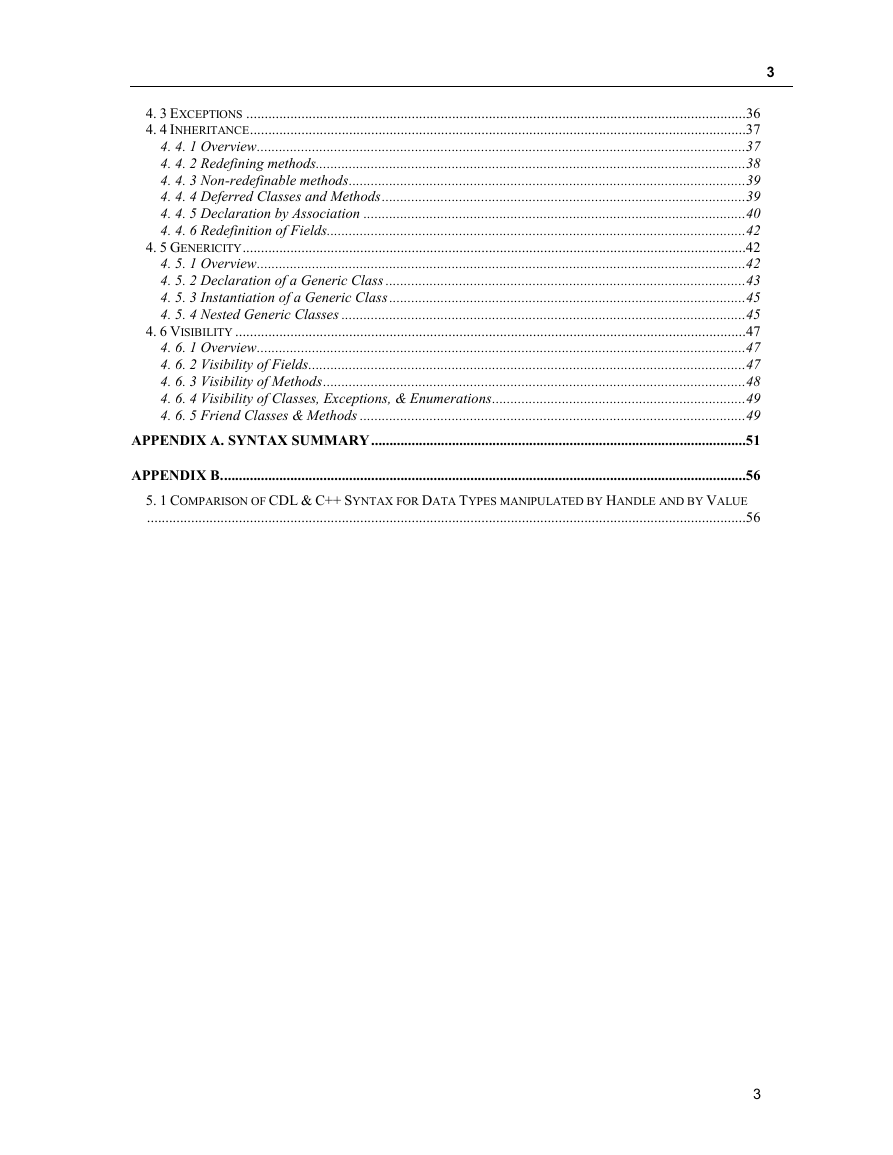
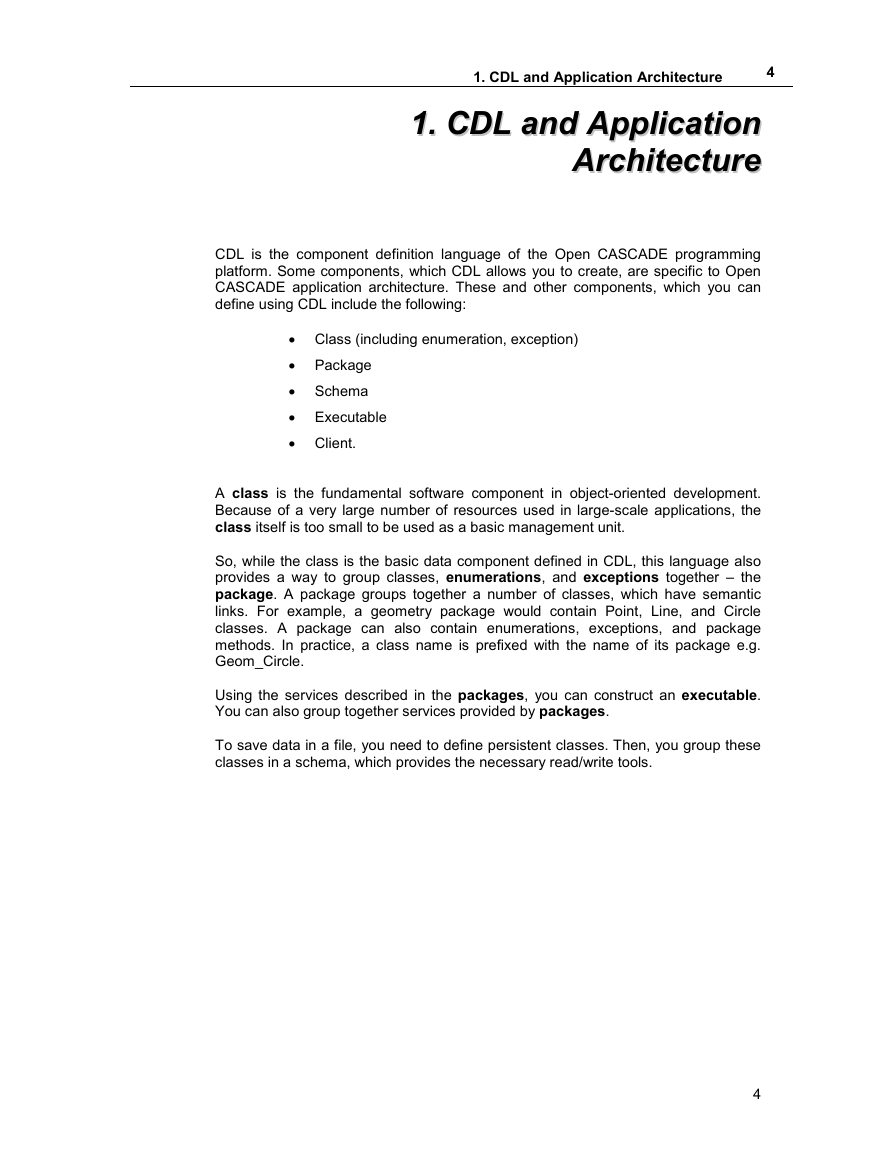
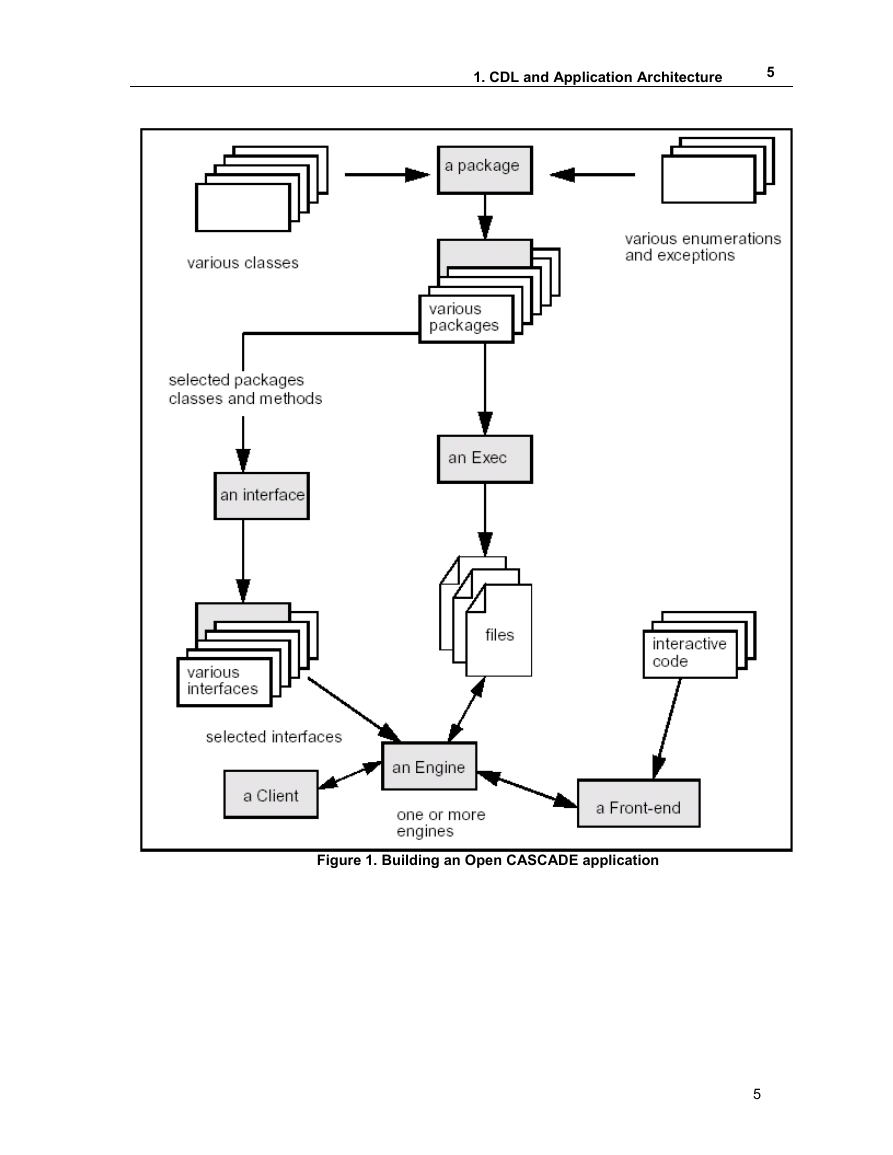

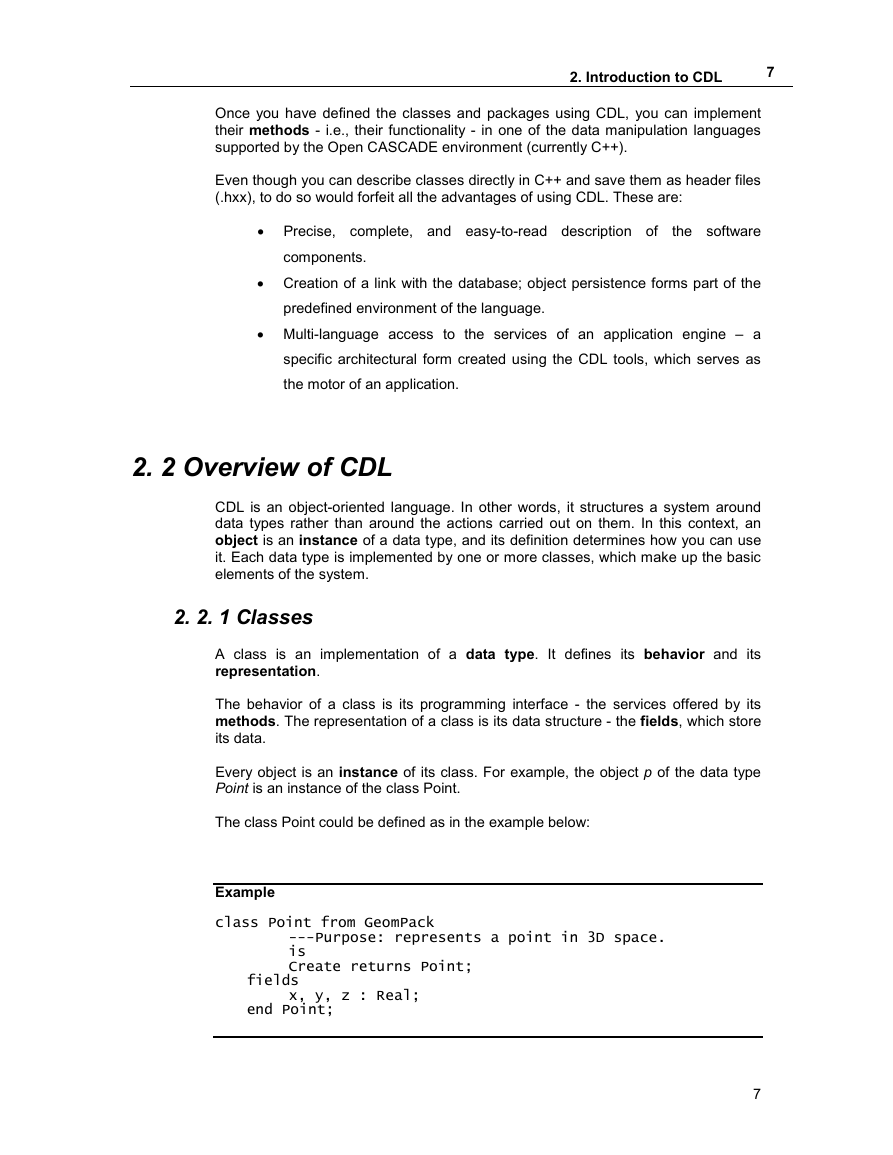








 2023年江西萍乡中考道德与法治真题及答案.doc
2023年江西萍乡中考道德与法治真题及答案.doc 2012年重庆南川中考生物真题及答案.doc
2012年重庆南川中考生物真题及答案.doc 2013年江西师范大学地理学综合及文艺理论基础考研真题.doc
2013年江西师范大学地理学综合及文艺理论基础考研真题.doc 2020年四川甘孜小升初语文真题及答案I卷.doc
2020年四川甘孜小升初语文真题及答案I卷.doc 2020年注册岩土工程师专业基础考试真题及答案.doc
2020年注册岩土工程师专业基础考试真题及答案.doc 2023-2024学年福建省厦门市九年级上学期数学月考试题及答案.doc
2023-2024学年福建省厦门市九年级上学期数学月考试题及答案.doc 2021-2022学年辽宁省沈阳市大东区九年级上学期语文期末试题及答案.doc
2021-2022学年辽宁省沈阳市大东区九年级上学期语文期末试题及答案.doc 2022-2023学年北京东城区初三第一学期物理期末试卷及答案.doc
2022-2023学年北京东城区初三第一学期物理期末试卷及答案.doc 2018上半年江西教师资格初中地理学科知识与教学能力真题及答案.doc
2018上半年江西教师资格初中地理学科知识与教学能力真题及答案.doc 2012年河北国家公务员申论考试真题及答案-省级.doc
2012年河北国家公务员申论考试真题及答案-省级.doc 2020-2021学年江苏省扬州市江都区邵樊片九年级上学期数学第一次质量检测试题及答案.doc
2020-2021学年江苏省扬州市江都区邵樊片九年级上学期数学第一次质量检测试题及答案.doc 2022下半年黑龙江教师资格证中学综合素质真题及答案.doc
2022下半年黑龙江教师资格证中学综合素质真题及答案.doc